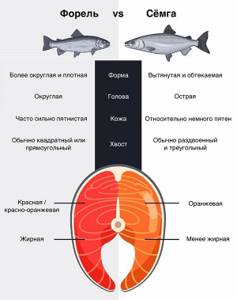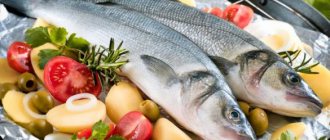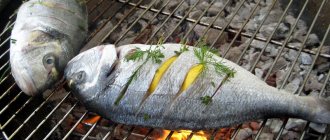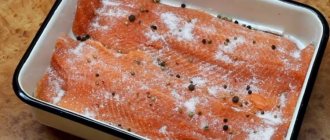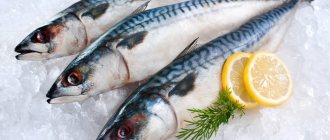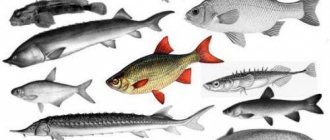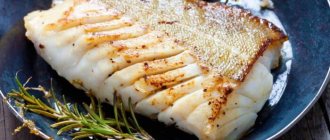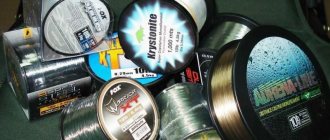Fish dishes should certainly be present in the diet of any person, since it has a positive effect on the body. The higher the quality of the product and the more expensive it is, the greater the effect. The modern market offers a huge range of fish that can satisfy any taste. Often on store shelves you can see two fish that are almost identical in appearance - salmon and salmon. They have a number of significant differences, but not everyone knows about it. In order not to make mistakes when choosing a product, you need to know what the difference is between salmon and salmon.
Which fish tastes better?
- Coho salmon 33%, 1548 votes
1548 votes 33%1548 votes - 33% of all votes
- Salmon 29%, 1335 votes
1335 votes 29%
1335 votes - 29% of all votes
- Trout 27%, 1233 votes
1233 votes 27%
1233 votes - 27% of all votes
- Chum salmon 9%, 394 votes
394 votes 9%
394 votes - 9% of all votes
- Pink salmon 3%, 119 votes
119 votes 3%
119 votes - 3% of all votes
Total votes: 4629
19.12.2019
×
You or from your IP have already voted.
Salmon family
The salmon family is a broad category of fish species, united by a common trade name - “red fish”. They received this name because of the characteristic color of the muscle fibers, which can vary from pale pink to deep red, almost burgundy. It is the color of the meat of these fish that makes it easy to distinguish them from most other representatives of the ichthyofauna, which have white or yellowish flesh.
Salmonids include:
- Noble salmon (salmon), living in the northern regions of the Atlantic Ocean - in the seas washing the coast of the Kola Peninsula, Scandinavia, northern Canada and the USA.
- Pacific salmon is a more extensive group in terms of species composition, distributed in the range of the Pacific Ocean and numerous seas on both sides of the equator, mainly in cold seas. Noble salmon is caught in large quantities on the Pacific coast of Chile; in cold waters bordering Antarctica; off the northern coast of the Japanese Islands, in the Primorsky Territory and especially in Kamchatka.
- Trout is a member of the salmon family that spends its entire life in fresh water bodies. The fish is widespread throughout the world, regardless of climate zones, but is rare due to excessive fishing.
Which fish is better to choose when preparing dishes?
Fish of the salmon family are valued for the presence of many useful substances and pleasant taste. Salmon has very few bones and can be used to prepare a variety of dishes.
As a rule, this is salted fish, steak or fish fillet. And, of course, it is best to cook it with fresh salmon. Which type of salmon fish to choose depends on everyone’s individual preferences. In terms of taste characteristics, different types of salmon do not differ significantly and have a pleasant taste.
Types and description
Salmonids vary greatly in size. Not so much - in appearance. It is this fact that causes difficulties for buyers in determining the type and price of fish presented on store shelves.
Varieties of salmon
In nature, salmon with red flesh are divided into several subfamilies:
- salmon;
- whitefish;
- graylings.
The last two subfamilies have significant differences from real salmon. Whitefish have white meat, while grayling have pink meat, but have a different structure and taste than salmon.
Noble salmon (salmon)
Large, up to 1.5 meters in length, fish. The weight of females can reach 45 kg. Males are smaller - up to 10 kg. It spends the main part of its life in the cold subarctic seas, entering the fresh waters of rivers only to spawn. It has a beautiful silver color of scales with small dark spots.
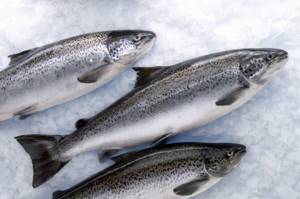
Pink salmon
The most numerous of the red fish. At the same time, the least valuable. The size of pink salmon is usually 50-70 centimeters and weighs up to 7 kg. Most often there are fish weighing 1-2.5 kg. Pink salmon meat contains little fat and has a bitter taste.
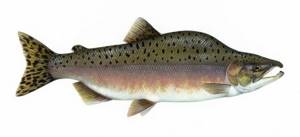
Chum salmon
Almost as numerous as pink salmon. The size of chum salmon is larger: body length - up to one meter, weight - up to 15 kg. The meat has a rich pink color, is fattier and more tender compared to pink salmon, but does not reach the standard of noble salmon.
Red salmon
Medium-sized salmon with a dark red “meaty” color. The size of the fish does not exceed 70 cm, and the weight is 7 kg. The meat is fatty and tender. The coloration during the mating season is characteristic, making it easy to distinguish sockeye salmon from other salmonids. Both males and females have a bright red body coloration with a dark green head.
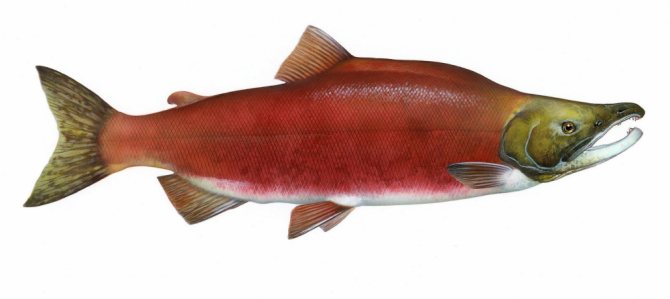
Coho salmon
A species of salmon distributed on the Pacific coasts of the Asian part of Russia, the northern coast of Japan, and the western coast of North America from Alaska to California. During the mating season before spawning, the body of the fish becomes rich crimson. The length rarely reaches 70 cm. Weight does not exceed 7 kg.
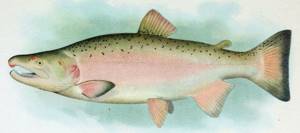
Chinook
The largest of the Pacific salmon. The size of the Asian variety reaches 180 cm and weighs up to 60 kg. In North America it is somewhat smaller. Length - up to 147 cm, weight - up to 40 kg. Among Pacific salmon, it is called the “prince of salmon” in Japan, and “king salmon” in North America.
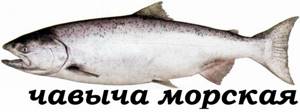
Lenok
Mainly freshwater fish, preferring clean, cold rivers and lakes of Asia and Siberia. Body length rarely reaches 80 cm with a weight of up to 8 kg. An extremely rare species.

Char
Arctic char is a large salmon fish. Body length - up to 80 cm, weight - up to 16 kg. It lives in rivers and lakes of the Arctic zone of Asia, Europe and North America. The fish is predatory, has migratory forms that enter fresh waters only to spawn, and permanent freshwater forms that do not leave their habitat.
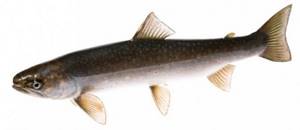
Trout varieties
Trout belongs to the salmon family and has pink or red muscle fibers. A distinctive feature of all trout species is their habitat. Unlike true salmon, they live primarily in fresh water.
There are three large groups of trout:
- Pacific;
- Atlantic;
- loaches (arctic loaches).
There are several species within each of these three groups.
Pacific
They live in rivers and lakes of the Pacific Ocean:
- Clark's salmon;
- gold;
- Biwa trout;
- Gil trout;
- Arizona;
- mykizha.
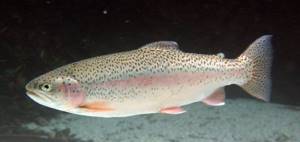
Atlantic
These include:
- stream and lake trout;
- Adriatic;
- Turkish flathead;
- marble;
- Amudarya;
- Sevan;
- summer trout.
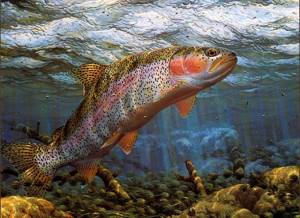
Loaches
Among them:
- Dolly Varden;
- American Palia;
- silver loach;
- lacustrine cristomere;
- bighead loach.
Which fish is the healthiest?
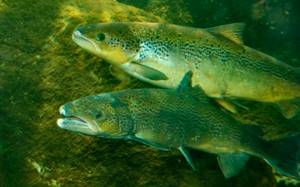
Fish of the salmon family is highly valued for its unique and unsurpassed taste, as well as the presence of many vitamins and microelements that have a positive effect on human life. In this regard, the meat of this fish is used to prepare all kinds of dishes, which is also due to the fact that salmon meat has a minimum of bones.
Basically, salmon is salted, and steaks and fillets are also prepared from it. The most important rule is to prepare dishes only from freshly caught salmon. Any type of fish belonging to the salmon family has excellent taste. Which type to choose depends on each person individually.
Main differences
The differences between trout and salmon are in size. In most cases, trout are small fish up to 30-40 cm in length and weighing 400-600 grams. The only exception is Atlantic sea trout.
Salmon can grow up to one meter and weigh up to 40 kg. Such specimens are extremely rare in nature. Thanks to artificial breeding and the use of hormones in complementary feeding, cultivated forms of trout and salmon have an average weight of 5-10 kg.
External
Depending on their habitat, trout have a variety of colors. The most beautiful is the rainbow trout. Fish differ somewhat in body shape, number of rays in fins, and head shape. Species easily mix with each other, forming hybrids and domesticated forms. The leaders in trout farming in cage conditions are Norway, Chile and China.
Salmon are much more diverse in color, size, body shape and habitats. The color of salmon meat in nature is very different, while in trout it is always pale pink or white.
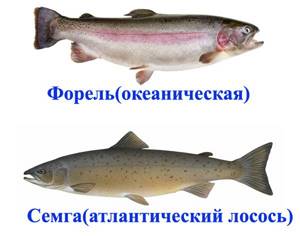
Habitats
Trout habitats are freshwater bodies of water with clean, cold water, richly saturated with oxygen. In lakes, trout stay near spring outlets at the bottom of reservoirs. River trout lives exclusively in mountain rivers with a hard rocky bottom and clear water.
Almost all types of salmon are “anadromous” fish. They spend most of their lives in the seas and oceans, and enter freshwater rivers only to spawn. The fry spends the first year of life in fresh water, which then goes to feed in salty sea waters rich in plankton.
Spawning
Trout has large caviar of bright orange or red color. The size of individual eggs is 4-6 mm. Sexual maturity in females occurs at three years of age, in males at two years. Young three-year-old trout spawn up to 500 eggs. As they age, the number of eggs increases to 1000 per female.
Females spawn on a rocky, pebble bottom. Some species use their tail fin to dig a hole into which they lay their eggs. Most simply attach it to the stones with a mucous secretion.
Salmon caviar has one characteristic feature - it is colored in bright orange-red colors. They vary significantly in size and have different tastes. All migratory salmon spawn in mountain rivers with rocky bottoms. The eggs are weakly attached to the substrate and float freely in the water column. Hatched larvae and fry feed mainly on the bodies of adults that died after spawning.
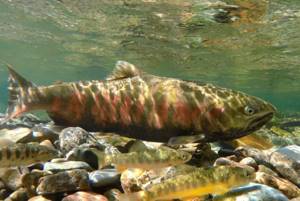
Fishing methods
Salmon and trout are important objects of commercial and sport fishing. On an industrial scale, salmon are caught in the period preceding spawning, when the females contain ripe caviar, which is a generally recognized delicacy.
Sport fishing with spinning rods and fly rods is considered one of the most exciting and exciting. Of particular value are large specimens weighing more than 10 kg, the landing of which can take several hours.
For lovers of trout and salmon fishing, there are special tackles:
- wading suits that allow you to stay in cold water for several hours;
- special construction spinning and fly fishing rods;
- floating cords, allowing you to visually control the casting and retrieving of the bait;
- special “fly” attachments that imitate the appearance of food insects;
- To catch char and taimen, they use baits that imitate mice and lemmings, which they readily feed on.
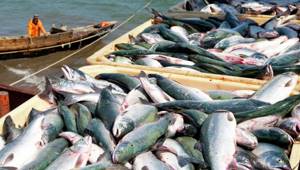
Medium fatty fish
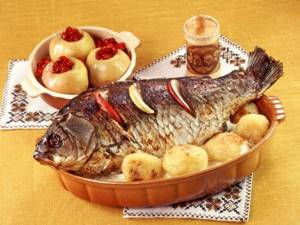
Such fish has a fat content of 4 to 8% and an energy value of 100 to 140 kcal.
The most famous river varieties are carp, catfish, trout, etc., sea varieties are chum salmon, horse mackerel, pink salmon, etc. Due to its balance, it is ideal for a healthy diet. Fish fat content table (average fat content)
| Name | Fat content per 100 grams |
| Carp | 5,3 |
| Som | 5,1 |
| Bream | 6,4 |
| Horse mackerel | 5 |
| Perch (sea) | 5,2 |
| Carp | 5,3 |
Why is there confusion?
The external similarity between salmon and trout creates confusion among consumers. Considering that most fish that go on sale are raised on farms in Norway and Chile, the size of commercial specimens differs little in length and weight.
It is also difficult to answer the question of which fish is fattier - trout or salmon. The color of the product can mislead the inexperienced consumer, since dyes are added to the feed, allowing the fish to be obtained from light pink (natural) to ruby red. And this always indicates artificial cultivation of fish on a farm.
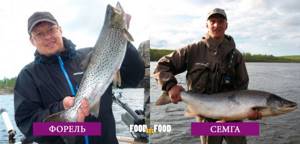
Progress is coming
There is another important point to cause confusion in the names themselves. This is modern marketing.
Which fish is better? On the shelves of shopping centers there are often price tags indicating not just the fish and the price, but also the area where it was caught. For example, inscriptions such as “artificially farmed salmon.”
You will also be interested in Top 10 largest trees in the world - ranking with photos
This implies that this species, from the smallest eggs, was grown in special fish farms. Such a hybrid is specially bred to be bred on a huge industrial scale, and their growth rate, naturally, is very different.
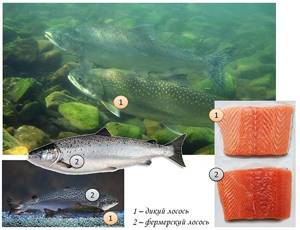
So, the following conclusion suggests itself:
- Real salmon is lake salmon or Atlantic salmon.
- The term “salmon” cannot be used to refer to any specific fish.
This is incorrect due to the following:
- This is a generalized name for an entire genus and cannot refer to just one specimen.
- Confusion is caused by local residents living where this family is caught and then sold to different countries.
- This is a marketing ploy by sellers or carriers to increase sales profits.
Features of salmon
The queen rightfully ranks first among red fish in size, quality of meat, fat content and abundance of spark. Cooks use all this when preparing delicious dishes.
Meat composition
The difference between salmon and other types of salmon is not only in size. There are fish of the salmon family and larger ones, for example, taimen. The main difference is in the taste and nutritional value of salmon meat. It is considered more valuable and therefore more expensive.
The price of 1 kg of fresh frozen or chilled salmon varies depending on the distance of the store, fishing location and logistics of delivery:
- Atlantic salmon (Norway) - from 800 to 1000 rubles. for 1 kg;
- Pacific salmon (Chile) - from 650 to 750 rubles per 1 kg.
Taste qualities
The taste qualities of salmon place it among the most valuable and nutritious fish, universally classifying it as a gourmet product. Meat is characterized by a high fat content - up to 15% per 1 kg of weight. Unlike most other fish, fat is evenly distributed throughout the muscle fibers.
You can visually distinguish salmon meat by cutting it. The muscle fibers are interspersed with veins of a lighter, almost white color, which is not typical for other salmon. You can eat salmon raw, lightly salted, smoked, or heat-treated.
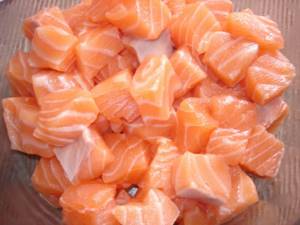
Useful properties of fish
Salmon fat contains a record amount of unsaturated fatty acids, which are a source of the Omega-3 antioxidant, which has a beneficial effect on cholesterol metabolism in the body. Regular consumption of lightly salted salmon helps reduce blood cholesterol levels, normalize the activity of the liver and pancreas, and supply the body with a large number of mineral compounds.
Due to its high fat content, salmon is not a dietary food product, despite its easy digestibility. Many people cannot eat this fish precisely because of its fat content.
Cooking secrets
Delicious dishes are prepared from salmon. People accustomed to fish prefer to eat it fresh (in the form of stroganina) or lightly salted. During heat treatment, meat becomes faded and loses tenderness.
Freshly salted salmon
Salting of fish is done using the dry or brine method. The first one is preferable.
Ingredients:
- salmon (piece) - 1 kg;
- curing coarse non-iodized salt - 40 g;
- black pepper - 1 g;
- sugar - 20 g.
A curing mixture is prepared from salt, sugar and ground black pepper. A piece of fish is cut along the ridge and the fillet is separated. The skin is usually not removed. The fish is rubbed with a curing mixture, wrapped in canvas and placed in a plastic bag so that the released juice does not leak. Place in the refrigerator for 6-12 hours.
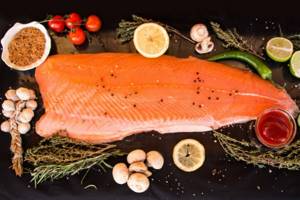
Pie with salmon
A traditional dish of the inhabitants of the northwestern European regions of Russia and Siberia.
Necessary:
- rich yeast dough - 1 kg;
- salmon fillet, stripped, without skin - 1 kg;
- onion, fried to caramel color - one large onion;
- salt - 15 g;
- boiled rice - 200 g;
- black pepper - 1 g;
- bay leaf - 2-3 leaves.
How to cook:
- Boiled, dried rice is laid out on a layer of dough.
- On top of the rice, close to each other, are pieces of salmon.
- Fried onions, salt, pepper, and bay leaf are distributed over the fish.
- The pie is covered with a second layer of dough 3-5 mm thick.
- Pinch around the perimeter.
- Five holes with a diameter of 1 cm are made in the cake.
To give the pie an elegant look, you can brush the top layer of dough with a mixture of egg yolk and water. By adding a teaspoon of sugar to the mixture, you get a dark glossy crust.
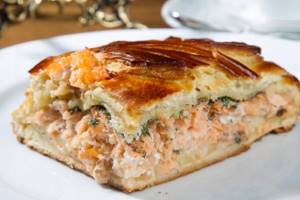
Stewed salmon
Ingredients:
- salmon steaks 300 g each - 2 pcs;
- onion - 1 piece;
- celery root or stems - 100 g;
- carrots - 2 pcs;
- lemon - 3-4 mugs 3-5 mm thick;
- salt - 10 g;
- sugar - one teaspoon;
- black pepper - 1 g;
- allspice peas - 3-4 peas;
- coriander seeds - 5-6 grains;
- caraway seeds - one teaspoon;
- bay leaf - 2 pcs;
- sour cream or cream - 200 g;
- water - 100 g.
Cooking method:
- The steaks are placed in a deep baking dish on top of onions fried until caramel-colored.
- The top is covered with a layer of vegetables, cut into rings 0.5-1 cm thick.
- Sour cream is diluted with water. There is no need to dilute the cream.
- Salt, sugar and spices are added.
- Pour in cream so that it completely covers the vegetables.
- Cover with a sheet of foil or heat-resistant baking film.
- Place in a preheated oven for 25-30 minutes.
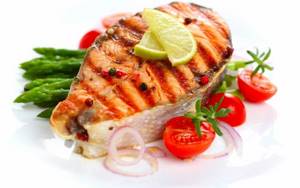
How to pickle caviar
Salmon may contain caviar. It is prepared separately from the fish. Carefully, so as not to crush the gallbladder, remove the ovary - two ovaries in a thin transparent film. The outer, rough film is removed manually. Thin films are removed by gently stirring with a fork, being careful not to crush individual eggs.
Dry salting of caviar is done with coarse non-iodized salt at the rate of 5 g of salt per 100 ml of caviar. You can add ground black pepper and ground garlic to it - no more than one clove per 100 ml of product. Salted caviar is placed in a sterile glass or ceramic container, and a 1-2 mm layer of vegetable oil is poured on top. Place in the refrigerator for 6-8 hours.
A large amount of caviar is salted in brine - a solution of table salt with additives that increase the shelf life of the product.
Brine recipe
Ingredients:
- red caviar - 1 kg;
- purified water - three liters;
- salt - 360 g;
- vegetable oil - 60 g;
- methenamine - 1 g;
- sorbic acid - 1 g;
- glycerin - 0.5 g.
Cooking process:
- Salt is dissolved in boiling water, gradually adding it and stirring.
- After the salt has completely dissolved, add the remaining ingredients and boil for 10 minutes.
- The solution is cooled to a temperature of 15-20 °C.
- The caviar, cleared of films, is placed in the brine solution for 7-8 minutes. The proportion of caviar to brine is 1:3 (1 kg of caviar - 3 liters of brine).
- Place on a sieve and allow the liquid to drain.
- The brine is boiled and cooled again.
- The second time, immerse the caviar in the solution for 7-8 minutes.
- Place on a sieve.
After complete drainage, the liquid is packaged in sterile glass jars and hermetically sealed. They are not pasteurized or sterilized. Store at a temperature not exceeding +5 °C.
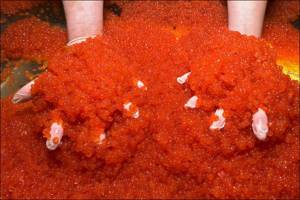
How to choose correctly
Most products are sold frozen. Trout can be found fresh or live for sale.
Fresh fish must have the correct shape, without external damage. There should be no white or green mucous coating on the surface of the scales. The gills of fresh fish are bright pink. If they are whitish, green or emit a putrid odor, the fish is not suitable for consumption in any form.
Frozen fish is selected without defects or mechanical damage. The tail should retain its shape and not be broken off. The carcass should be completely covered with a layer of ice glaze 2-3 mm thick.
If you purchase packaged steaks, first of all, pay attention to the packaging date and warranty period. If frozen liquid has accumulated in the corner of the tray, this indicates that the storage conditions were violated and the product was defrosted.
Beautiful presentation
Lightly salted salmon is served on dishes, cut into thin layers across the fibers of the loin, 2-3 millimeters thick. The belly (tesha) is usually served separately from the sirloin (balyk). Garnish with thinly sliced lemon slices, pitted olives or capers.
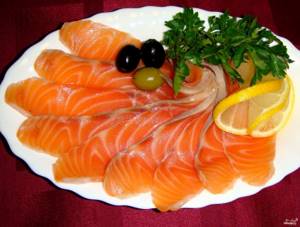
Recipes with salmon or salmon
Quick salmon
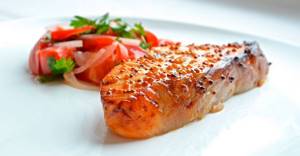
- Place the salmon fillet in a baking dish and drizzle with a little olive oil.
- Place the fish in a preheated oven (180°C) for 15-30 minutes.
- The cooked fish is served with tartar sauce and a side dish of your choice.
Creamy salmon
- Cut 1.5 kg salmon fillet into portions. Add salt.
- Sprinkle each piece of fish with a small amount of lemon juice and place in a bowl. Wait about 15 minutes.
- Heat a frying pan with vegetable oil and quickly fry the fish for 1 minute.
- Transfer the salmon pieces to a baking dish.
- Melt a small piece of butter in a saucepan and fry chopped green onions (about one bunch) in it. Fry for about 2-3 minutes and stir constantly.
- In a separate bowl, mix 0.5 liters of sour cream, 1 tbsp. mustard, salt and ground black pepper.
- Add the mixture to the pan with the green onions and heat slightly. The sauce must be stirred constantly.
- Pour the sauce into the fish pan.
- Sprinkle 2 tbsp on top. bread crumbs and place in a preheated oven for 30 minutes.
- Sprinkle the prepared dish with green onions.
Salmon salad
- Take 1 can of canned salmon and place it in a bowl.
- Remove the bones and mash the fillet with a fork.
- Grate 100 g of cheese.
- Finely chop 5 boiled eggs.
- Mix everything in a separate bowl and add 0.3 cans of canned green peas, salt and ground black pepper.
- Season the salad with mayonnaise and add herbs.
Salmon baked in foil
- Salt the salmon steak on both sides.
- Prepare a baking sheet by placing foil on it.
- Place the fish on a baking sheet. Sprinkle salmon with black pepper and basil to taste. Place small lemon slices on top.
- Wrap the fish in foil and place in a preheated oven for 20-25 minutes.
- The prepared dish can be sprinkled with herbs.
Thus, we can say that salmon and salmon have minimal differences in their biological characteristics. However, let us remember that salmon is a separate species of fish, and salmon is part of the salmon family. Salmon has many nutrients for the human body.
It contains huge amounts of healthy protein and “good” fat. For example, 100 grams of this fish provides a person with the daily requirement of vitamin D. And this is practically the only natural product with such content.
More about trout
In terms of taste, trout differs from salmon. Some fans rate it as a more tender and flavorful fish.
Meat composition
Trout is not as fatty as salmon. It contains no more than 4% fat. It is more suitable for dietary nutrition.
This fish also contains unsaturated fatty acids and Omega-3 complex. The fillet is less structured and does not have white streaks.
Taste benefits
Trout is a delicious fish. It is consumed less often than salmon in salted form, and is often subjected to heat treatment. The habitat and greater susceptibility to helminth infection have an effect.
Fresh trout is baked in foil with a minimum amount of spices or smoked hot. Then the meat retains its juiciness and tender structure.
Benefits for the body
In terms of health benefits, trout is no different from salmon. Due to its lower fat content, it is more suitable for children's and dietary nutrition, without overloading the liver and pancreas with the work of producing enzymes. Contains a large number of microelements.

Use in cooking
Trout is not inferior in taste to most types of salmon, and in some cases even surpasses the meat of low-value salmon, such as pink salmon. In cooking it is considered a delicacy.
Trout baked in foil
Ingredients:
- fish - one carcass (300-400 g);
- salt - 5 g;
- black pepper - 0.5 g;
- onion - 1 piece;
- lemon zest - 1 g.
Cooking method:
- The gutted fish is rubbed with salt mixed with pepper and lemon zest on the inside of the belly.
- Half an onion, cut into rings, is placed in the belly.
- Place the fish on a sheet of foil and place the remaining onion rings on top.
- Cover with foil and press tightly into the shape of the carcass.
- Place in an oven preheated to 150°C for 20-25 minutes.
- Serve whole, garnished with thin slices of lemon, salted olives and capers.
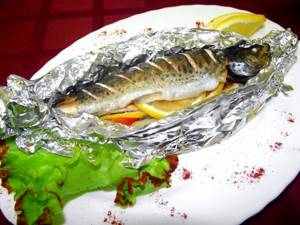
Hot smoked trout
Ingredients:
- trout - one carcass;
- salt - 5 g;
- ground black pepper - 0.5 g.
Cooking process:
- The fish carcass is gutted.
- Wash and dry with a napkin the outside and inside of the abdomen.
- The inner surface of the fish is rubbed with salt.
- Place sawdust from fruit trees or black alder on the bottom of the smokehouse in a layer of 1.5-2 cm.
- The carcass is laid out on slats made of fruit wood (apple, pear, cherry).
- Close the smokehouse with a lid and place it on an open fire.
Smoking time is 25-30 minutes.
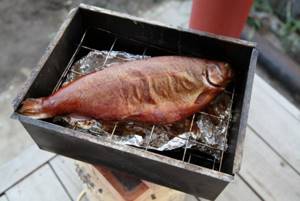
Using caviar
Trout contains a small amount of red caviar - 50-70 grams. In terms of taste, it is not inferior to other salmon products. It is salted in the same way as salmon caviar, following the above recipe.
How to choose in a store
Trout, more often than other salmon, is sold live or chilled. When choosing, pay special attention to the color of live fish. Live brook and rainbow trout should be brightly colored. A gray, faded back indicates that the fish has recently spawned. It is coarser and contains little fat.
How to cook salmon
In most cases, the product is consumed salted or smoked. Salmon is also used to make dressings, salads, and rolls. You can even bake pies from it. Fresh fish can be used to prepare delicious fish soup or amazing cream soup.
If desired, salmon can be cooked fried and combined with potatoes or other vegetables. An excellent option would be to cook fried fish with honey. To preserve maximum beneficial properties, it is best to bake meat.
Pasta with salmon

For this dish you need to take the following ingredients:
- 200 g salmon;
- 200 g spaghetti;
- 200 g tomatoes;
- 3 cloves of garlic;
- 2 tablespoons olive oil;
- a little parsley and basil;
- salt and spices.
To prepare this tasty and healthy dish, you need to do the following:
- Chop the garlic and fry it in olive oil.
- Blanch and peel the tomatoes. After that, cut them into cubes and simmer for 3 minutes in a frying pan.
- Cut the salmon into cubes and add to the pan.
- Add chopped herbs.
- Cook the pasta until almost done.
- Place on a plate and mix with cooked fish.
Marinated salmon
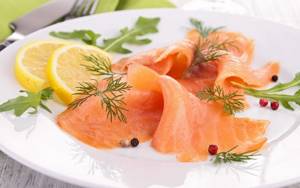
For this dish you should prepare the following ingredients:
- 2 cups wine vinegar;
- 2 cups broth;
- 2 cloves of garlic;
- 1 onion;
- Bay leaf;
- fresh cilantro;
- salt;
- peppercorns;
- red hot pepper;
- 1 kg salmon.
To marinate salmon, you need to do the following:
- Boil water with spices for 5 minutes.
- Place the fish in the broth and cook until almost done.
- Add vinegar, herbs and garlic.
- Place the fish in a suitable container and fill with vinegar solution.
- When the composition has cooled, it must be placed in the refrigerator for at least 6 hours.
comparison table
The main differences and similarities between trout and salmon are clearly presented in the following table.
| Type of fish/Differences | Salmon | Trout | Salmonidae |
| Body length | 70-100 cm | 25-40 cm | 40—120 cm |
| Body mass | up to 40 kg | 300-400 g | 1—40 kg |
| Habitats | cold waters of the Atlantic Ocean | lakes of northwestern Europe, Scandinavia, high mountain lakes of the Caucasus, Central Asia | mountain rivers of the Kola Peninsula, Scandinavia, Canada, Alaska |
| Muscle fiber color | from light pink to deep red | white, yellow, pink | from pale pink to deep red |
| Amount of caviar | up to 3 kg from one female | 500-1000 eggs (30-50 g) | from 100 g to 5-6 kg |
| Reaching puberty | females after three years, males - two years | females after three years, males after two years | females after three years, males - two years |
Beautiful presentation
Salmon and other fish of the salmon family are in great demand among Russian buyers, especially on the eve of the holidays. This is due to the fact that salted trout and salmon have a beautiful red color. Of course, the easiest way is to buy a product in vacuum packaging, which is already pre-cut into thin slices. However, this option is expensive and is not always of good quality.
Instead of salmon, an unscrupulous producer may offer the buyer ordinary herring, tinted with a bright dye. Therefore, the best option is to buy salted bellies, which are sold by weight in specialized fish stores and at agricultural food markets. Of course, you will have to tinker a little, peeling the bellies from the skin and slicing them thinly, but the product will definitely be of high quality and natural. Here are several options for beautifully serving slices of canned red fish:
- “roses” made from pieces of salmon decorating the salad,
- Thin slices served on white bread, brushed with butter,
- Pieces of fish coated with cream cheese and rolled into neat little rolls. Ready rolls can be secured using toothpicks or wooden skewers,
- Pancakes, generously poured with melted butter and decorated with slices, are a traditional delicacy of Russian cuisine.
Which variety is better to buy?
Preference is always given to live fish over dormant ones and wild ones over domesticated forms.
River and rainbow trout contain less fat. Their meat is coarser, but more flavorful than that of the oceanic meat grown in fish farms in cages.
Wild fish contains almost no pesticides or heavy metal salts. It is completely free from antibiotics, growth hormones and coloring agents added to farmed fish feed.
Wild salmon is caught mainly in the coastal waters of Norway and near the Kola Peninsula. It almost never goes on sale due to its scarcity.
99% of the fish on store shelves are artificially grown fish in cages, to stimulate the growth of which antibiotics and hormones are used, and the meat is colored with the addition of food coloring.
The meat of such fish has high taste, but dubious benefits for the body.
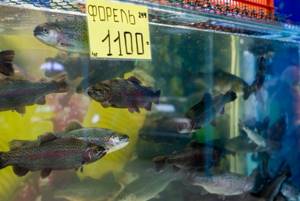
Salmon in dietetics
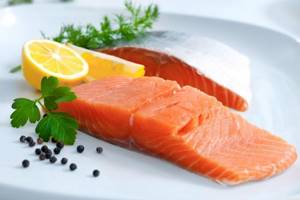
Despite the fairly high calorie content of the product, salmon can be used in dietary nutrition. At the same time, it is important to remember a sense of proportion.
You can eat boiled salmon without worrying about your figure. However, this fish should not be overused. When following a diet, any fatty product can be replaced with salmon. Fish fills you up quickly and contains fewer calories than meat dishes.
The caviar of this fish can be eaten by pregnant women. This product is also very useful during lactation. It is important to monitor the child’s reactions. Sometimes these products cause allergies.
What tastes better?
The taste of the fish is approximately the same, characteristic of all salmon. It is impossible to say for sure that one of them is tastier.
Salmon is fattier. This difference manifests itself when frying steaks and baking the carcass in the oven. The trout meat may seem a little dry. When salting, the difference in fat content is practically not felt.
We recommend: What is urbech and how to use it for health benefits?
